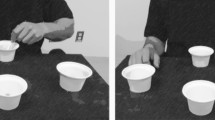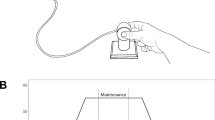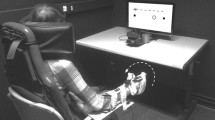Abstract
The task of sliding a nut from a rod has been used to study manual slowing in old age (Smith et al. in Neurology 53:1458–1461, 1999; Neurobiol Aging 26:883–890, 2005). In this experiment, we sought to determine if the age-related slowing in this task occurs with losses of motor precision, as indicated by the forces exerted on the rod. The forces exerted by the nut on the rod were monitored along with the kinematics of the hand in old and young adults while they attempted to lift a nut from three vertically oriented rods of different shape (straight, single curve, double curve). Old adults performed the task 64% slower than young adults for the straight rod, 100% slower for the single-curve rod, and 80% slower for the double-curve rod. Old adults did not differ from the young adults in the amount of force exerted against the rods in the horizontal plane, or in the steadiness of these forces, but exerted greater force impulses in the vertical direction over the course of a trial (359% straight, 236% single curve, 214% double curve) and much more force in the vertical direction (255% straight, 267% single curve, 159% double curve). Old adults also performed the task with 35% greater average roll of the hand into pronation. We suspect that old adults tilted the nut, even for the straight rod, dragging it against the rod to create the elevated vertical forces. These observations support previous speculation that old adults do not control the external moments applied to grasped objects as well as young adults.






Similar content being viewed by others
References
Bellgrove M, Phillips J, Bradshaw J, Gallucci R (1998) Response (re-)programming in aging: a kinematic analysis. J Gerontol A Biol Sci Med Sci 53:M222–M227
Birznieks I, Jenmalm P, Goodwin A, Johansson R (2001) Encoding of direction of fingertip forces by human tactile afferents. J Neurosci 21:8222–8237
Cauna N (1965) The effects of aging on the receptor organs of the human dermis. In: Montagna W (ed) Advances in biology of the skin, vol VI. Pergamon, New York, pp 63–96
Cerella J (1990) Information processing rates in the elderly. In: Birren JE, Schaie KW (eds) Handbook of the psychology of aging, 3rd Edition edn. Academic Press, New York, pp 201–221
Cole KJ (1991) Grasp force control in older adults. J Motor Behav 23:251–258
Cole K (2006) Age-related directional bias of fingertip force. Exp Brain Res 175:285–291
Cole K, Rotella D (2001) Old age affects fingertip forces when restraining an unpredictably loaded object. Exp Brain Res 136:535–542
Cole K, Rotella D, Harper J (1999) Mechanisms of age-related changes in fingertip forces during precision gripping and lifting in adults. J Neurosci 19:3238–3247
Darling WG, Peterson CR, Herrick JL, McNeal DW, Stilwell-Morecraft KS, Morecraft RJ (2006) Measurement of coordination of object manipulation in non-human primates. J Neurosci Methods 154:38–44
Desrosiers J, Hebert R, Bravo G, Rochette A (1999) Age-related changes in upper extremity performance of elderly people: a longitudinal study. Exp Gerontol 34:393–405
Enoka R, Christou E, Hunter S, Kornatz K, Semmler J, Taylor A, Tracy B (2003) Mechanisms that contribute to differences in motor performance between young and old adults. J Electromyogr Kinesiol 13:1–12
Gescheider GA, Beiles EJ, Checkosky CM, Bolanowski SJ, Verrillo RT (1994a) The effects of aging on information-processing channels in the sense of touch. 2. Temporal summation in the P channel. Somatosens Mot Res 11:359–365
Gescheider GA, Bolanowski SJ, Hall KL, Hoffman KE, Verrillo RT (1994b) The effects of aging on information-processing channels in the sense of touch. 1. Absolute sensitivity. Somatosens Mot Res 11:345–357
Gescheider GA, Edwards RR, Lackner EA, Bolanowski SJ, Verrillo RT (1996) The effects of aging on information-processing channels in the sense of touch.3. Differential sensitivity to changes in stimulus intensity. Somatosens Mot Res 13:73–80
Graves AE, Kornatz KW, Enoka RM (2000) Older adults use a unique strategy to lift inertial loads with the elbow flexor muscles. J Neurophysiol 83:2030–2039
Greenhouse SW, Geisser S (1958) Extension of Box’s results on the use of the F distribution in multivariate analysis. Ann Math Stat 29:95–112
Holden M, Ventura J, Lackner JR (1994) Stabilization of posture by precision contact of the index finger. J Vestib Res 4:285–301
Hsiao S (2008) Central mechanisms of tactile shape perception. Curr Opin Neurobiol 18:418–424
Jebsen RH, Taylor N, Trieschmann RB, Trotter MJ, Howard LA (1969) An objective and standardized test of hand function. Arch Phys Med Rehabil 50:311–319
Jeka JJ (1997) Light touch contact as a balance aid. Phys Ther 77:476–487
Jeka JJ, Schoner G, Dijkstra T, Ribeiro P, Lackner JR (1997) Coupling of fingertip somatosensory information to head and body sway. Exp Brain Res 113:475–483
Jenmalm P, Birznieks I, Goodwin A, Johansson R (2003) Influence of object shape on responses of human tactile afferents under conditions characteristic of manipulation. Eur J Neurosci 18:164–176
Kellor M, Frost J, Silberberg B, Iverson I, Cummings R (1971) Hand strength and dexterity. Am J Occup Ther 25:77–83
Kenshalo DR (1986) Somesthetic sensitivity in young and elderly humans. J Gerontol 41:732–742
Kinoshita H, Francis PR (1996) A comparison of prehension force control in young and elderly individuals. Eur J Appl Physiol 74:450–460
Lackner JR, DiZio PA (2000) Aspects of body self-calibration. Trends Cogn Sci 4:279–288
Manning H, Tremblay F (2006) Age differences in tactle pattern recognition at the fingertip. Somatosens Mot Res 23:147–155
Morgan M, Phillips JG, Bradshaw JL, Mattingley JB, Iansek R, Bradshaw JA (1994) Age-related motor slowness—simply strategic? J Gerontol 49:M133–M139
Olafsdottir H, Zhang W, Zatsiorsky V, Latash M (2007) Age-related changes in multifinger synergies in accurate moment of force production tasks. J Appl Physiol 102:1490–1501
Schmidt RF, Wahren LK, Hagbarth KE (1990) Multiunit neural responses to strong finger pulp vibration. I. Relationship to age. Acta Physiol Scand 140:1–10
Shim J, Lay B, Zatsiorsky V, Latash M (2004) Age-related changes in finger coordination in static prehension tasks. J Appl Physiol 97:213–224
Smith C, Umberger G, Manning B, Slevin J, Wekstein D, Schmitt F, Markesbery W, Zhang Z, Gerhardt G, Kryscio R, Gash D (1999) Critical decline in fine motor hand movements in human aging. Neurol 53:1458–1461
Smith C, Walton A, Loveland A, Umberger G, Kryscio R, Gash D (2005) Memories that last in old age: motor skill learning and memory preservation. Neurobiol Aging 26:883–890
Stevens J (1992) Aging and spatial acuity of touch. J Gerontol Psychol Sci 47:35–40
Stevens JC, Patterson MQ (1995) Dimensions of spatial acuity in the touch sense: changes over the life span. Somatosens Mot Res 12:29–47
Stevens JC, Cruz LA, Marks LE, Lakatos S (1998) A multimodal assessment of sensory thresholds in aging. J Gerontol Ser B Psychol Sci 53:P263–P272
Tremblay F, Wong K, Sanderson R, Cote L (2003) Tactile spatial acuity in elderly persons: assessment with grating domes and relationship with manual dexterity. Somatosens Mot Res 20:127–132
Tremblay F, Mireault AC, Dessureault L, Manning H, Sveistrup H (2004) Postural stabilization from fingertip contact: I. Variations in sway attenuation, perceived stability and contact forces with aging. Exp Brain Res 157:275–285
Tremblay F, Mireault A, Dessurault L, Manning H, Sveistrup H (2005) Postural stabilization from fingertip contact: II relationships between age, tactile sensibility and magnitude of contact forces. Exp Brain Res 164:155–164
Verrillo RT (1979) Change in vibrotactile thresholds as a function of age. Sens Process 3:49–59
Welford A (1958) Aging and Human Skill. Oxford University Press for the Nuffield Foundation, Oxford
Welford AT, Norris AH, Shock NW (1969) Speed and accuracy of movement and their changes with age. Acta Psychol 30:3–15
Author information
Authors and Affiliations
Corresponding author
Rights and permissions
About this article
Cite this article
Cole, K.J., Cook, K.M., Hynes, S.M. et al. Slowing of dexterous manipulation in old age: force and kinematic findings from the ‘nut-and-rod’ task. Exp Brain Res 201, 239–247 (2010). https://doi.org/10.1007/s00221-009-2030-z
Received:
Accepted:
Published:
Issue Date:
DOI: https://doi.org/10.1007/s00221-009-2030-z




